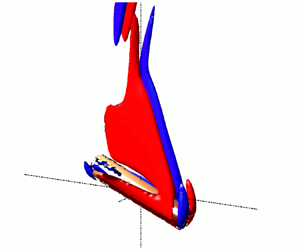Article contents
Path instabilities of freely falling oblong cylinders
Published online by Cambridge University Press: 27 November 2024
Abstract

This paper presents numerical simulations of the free fall of homogenous cylinders of length-to-diameter ratios  $2$,
$2$,  $3$ and 5 and solid-to-fluid-density ratios
$3$ and 5 and solid-to-fluid-density ratios  $\rho _s/\rho$ going from 0 to 10 in transitional regimes. The path instabilities are shown to be due to two types of transitional states. The well-known fluttering state is a solid mode, characterised by significant oscillations of the cylinder axis due to a strong interaction between the vortex shedding in the wake and the solid degrees of freedom. Weakly oscillating, mostly irregular trajectories, are fluid modes, associated with purely fluid instabilities in the wake. The interplay of solid and fluid modes leads to a varying scenario in which the length-to-diameter and density ratios play an important role. The description is accompanied by the presentation of the identified transitional states in terms of path characteristics and vorticity structure of the wakes and by bifurcation diagrams showing the evolution of asymptotic states with increasing Galileo numbers. There appears to be a strong difference between the behaviour of cylinders of aspect ratio
$\rho _s/\rho$ going from 0 to 10 in transitional regimes. The path instabilities are shown to be due to two types of transitional states. The well-known fluttering state is a solid mode, characterised by significant oscillations of the cylinder axis due to a strong interaction between the vortex shedding in the wake and the solid degrees of freedom. Weakly oscillating, mostly irregular trajectories, are fluid modes, associated with purely fluid instabilities in the wake. The interplay of solid and fluid modes leads to a varying scenario in which the length-to-diameter and density ratios play an important role. The description is accompanied by the presentation of the identified transitional states in terms of path characteristics and vorticity structure of the wakes and by bifurcation diagrams showing the evolution of asymptotic states with increasing Galileo numbers. There appears to be a strong difference between the behaviour of cylinders of aspect ratio  $L/d=3$ and 5. A similar contrast is stated between light cylinders of density ratios
$L/d=3$ and 5. A similar contrast is stated between light cylinders of density ratios  $\rho _s/\rho \le 2$ and dense cylinders of density ratios 5 and 10. Finally, the question of the scatter of values of the drag coefficient and of the frequency of oscillations raised in the literature is addressed. It is shown, that in addition to external parameters (Galileo number, density and aspect ratio) the amplitude of oscillations characterising the instability development is to be taken into account to explain this scatter. Fits of the simulation results to simple correlations are proposed. Namely that of the drag coefficient proves to be accurate (better than 1 % of accuracy) but also that of the Strouhal number (a few per cent of accuracy) may be of practical use.
$\rho _s/\rho \le 2$ and dense cylinders of density ratios 5 and 10. Finally, the question of the scatter of values of the drag coefficient and of the frequency of oscillations raised in the literature is addressed. It is shown, that in addition to external parameters (Galileo number, density and aspect ratio) the amplitude of oscillations characterising the instability development is to be taken into account to explain this scatter. Fits of the simulation results to simple correlations are proposed. Namely that of the drag coefficient proves to be accurate (better than 1 % of accuracy) but also that of the Strouhal number (a few per cent of accuracy) may be of practical use.
- Type
- JFM Papers
- Information
- Copyright
- © The Author(s), 2024. Published by Cambridge University Press
References
- 1
- Cited by



